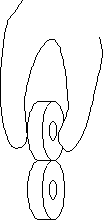
Attractive and repulsive at the same time
Introduction
A central cylindrical magnet can be oriented to attract cylindrical magnets to its rim. The magnets on the rim repel each other. This combination can be used to investigate collisions and symmetry as well as to model electric current flow.
Materials
A Cylindrical magnet with its poles on the flat faces. (For example Two donut shaped ferrite magnet from Radio Shack about 2.5 cm in diameter and 0.5 cm thick)
Six smaller cylindrical magnets with poles on their faces. (For example 12 disk shaped ferrite magnets from Radio Shack, about 1 cm in diameter and 0.5 cm thick.)
Explorations
There are 4 explorations presented below in increasing order of difficulty.
To Do and Notice

Place one magnet on the rim. Grasp the central magnet between your thumb and forefinger. Lift both magnets into the air and begin to swing the free magnet back-and-forth. See if you can get it to orbit without breaking free. It is easy to make a small magnet orbit a larger one, harder to make a large donut magnet orbit.
What’s Going On?
The north pole of the held magnet is next to the south pole of the free magnet and vice-versa so that the magnets attract. The attraction provides a force which can hold the orbiting magnet attached to the central magnet as it moves around in a circle. Go faster and faster and eventually the orbiting magnet will escape. When the orbiting magnet is at the bottom, the magnetic force must hold it in place against gravity and also provide an extra force to keep it moving in a circle. When the orbiting magnet velocity is large enough the magnetic force can no longer hold it in orbit and it will escape.
To Do and Notice
Place two smaller magnets on the rim of a larger
magnet. Grasp the central magnet between your thumb and forefinger.
Lift all three magnets into the air. Notice how the two rim magnets
repel each other to opposite sides of the central magnet.
Flick one rim magnet to the side with a free hand. It will orbit the
central magnet and collide with the other rim magnet. During the
collision it will stop dead in its tracks and the other rim magnet
will start to move with the same velocity. Notice that the rim
magnets never actually touch each other.
You can also make the outer magnets move around the central magnet
without flicking them, simply move the central magnet in a circle.
When you find the correct frequency and size for the circular motion,
you can make one magnet appears to orbit the central magnet and pass
through the other rim magnet.
What’s Going On?
If the South pole of the central magnet points up,
then the north poles of both orbiting magnets also point up. The
orbiting magnets are attracted to the central magnet and repel each
other.
When a moving object collides with a stationary object of the same
mass the moving object can stop while the initially stationary object
can start moving at the same speed. When this happens rapidly you can
experience the illusion that one magnet moves through the
other.
To Do and Notice
Add rim magnets one at a time. Notice how three
magnets form an equilateral triangle, four magnets a square, five a
regular pentagon and six a regular hexagon.
Notice that if the central magnet is not uniformly magnetized
asymmetries will appear.
What’s Going On?
These patterns are all in equilibrium. Move one rim magnet closer
to another and the repulsive force between them gets stronger pushing
them back into the initially symmetric position.
Hold the magnets in a vertical plane and notice ow the symmetry is broken. Gravity pulls two of the magnets down. The molecule modeled here is water, the Mickey Mouse molecule.
To Do and Notice
Place four, five or six rim magnets around the central magnet. Push one rim magnet gently to the side notice how all the rim magnets begin to move. As another rim magnet moves into position under your finger push it to the side too.

This activity works even better if you can put a spacer under the center of the magnet so that the smaller magnets do not rub against the table as they move around. For a spacer I use a magnetic coin.
What’s Going On?
The rim magnets all repel each other magnetically. Changes in the magnetic field which carries the repulsive force from one magnet to the next move at the speed of light. All the other magnets feel the changed magnetic force shortly after you begin to move the first magnet.
So What
The magnets model what happens in DC electrical circuits such as the one that powers your car headlights. When you close the headlight switch, electrons begin to move throughout your car wiring and the lights come on. It takes a few hours for an electron to travel through your car wiring from the battery to the headlights. The electrical force which makes the electrons begin to move travels through the wire at a large fraction of the speed of light. As soon as the electrons in the headlights begin to move the headlights come on. Thank goodness, there is no need to wait for an electron to make the journey all the way from the battery to the headlight.
|
Scientific Explorations with Paul Doherty |
|
30 May 2000 |